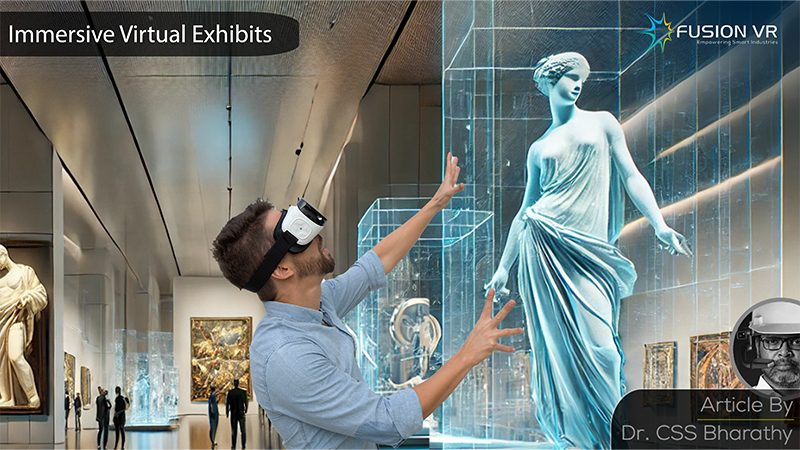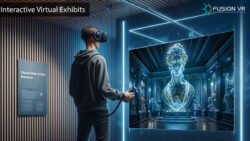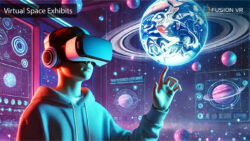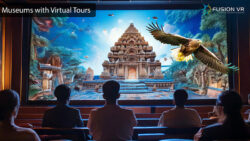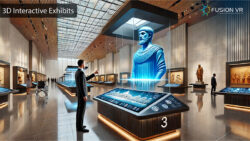Experience centers are spaces carefully designed to provide information, engage and deliver services to an entity’s stakeholders. These entities could be government and private organizations, institutions, political parties or even individuals. The goal of many such corporate experience centers is to be highly interactive and maximize their organization’s engagement with its customers. Designing such experience centers and interactive museums requires the collaborative efforts of experts from various domains and key stakeholders to deliver the experience and engagement the organization desires. It may also be obvious to many about the role of new technologies in developing the experiences in an experience center.
Museums and entertainment centers have taken the lead in the development of interactive experiences within their spaces. They use a wide range of technologies in museums and experience centers and the most prominent of those technologies have been Virtual Reality (VR) and Augmented Reality (AR). Designing an experience center with AR and VR requires a comprehensive understanding of the user experience desired and the technologies that are brought into play. It also requires the integration of the latest hardware, intuitive software, and engaging content These elements combined with the expertise in these technologies and a strong creative focus, help deliver unforgettable interactive and immersive experiences.
There has been a wave of innovation in the technologies that support the development and functioning of AR VR experience centers. People are experiencing newer ways to interact with the digital content being developed. The smartphone kickstarted this phenomenon, but we have various newer devices such as the Apple Vision Pro which are making these experiences go mainstream. So what are the hardware and software technologies that are helping experience centers showcase the latest innovations?
Experiencing virtual reality content requires the use of sophisticated headsets that the user needs to do. These headsets became popular with the gaming fraternity and swiftly caught the attention of various other domains that saw the unparalleled potential of virtual reality. This has spawned the growth of more sophisticated, efficient and comfortable headsets. VR headsets completely cover the eyes, visually cutting off the user from the surrounding reality and immersing them into a digitally created virtual world. These headsets are equipped with advanced high-resolution LCD displays and optics that deliver a wider field of vision and a very realistic experience. They are also equipped with tracking systems that capture the movement of the user and The Meta Quest 3, and Valve Index are just a few of the most advanced headsets available for use at the experience centers. These headsets can be tethered or standalone to enjoy a VR experience. The VR experience is truly innovative for people to obtain experiences that are difficult, expensive or impossible in reality. In addition, VR delivers futuristic experiences and those that delve deep into our past.
Another innovation that experience centers have started to showcase is haptic feedback. Simply put, haptic technology uses touch, vibration etc to respond to the user about their interactions with digital devices. This could be as simple as the sound generated while clicking switches or buttons that mimic real-life experiences. This technology breaks down some of the barriers between the real and the virtual. As visitors experience VR exhibits and navigate in the virtual environment, manipulating the controls to perform certain activities, we can deliver an immersive experience. This technology enables tactile sensations that coincide with whatever the user is hearing or seeing. The incorporation of haptic feedback enables these interactive center experiences to be more realistic, engaging and immersive for visitors. In addition to these, there is the infusion of spatial audio with technologies like Dolby Atmos and Bose AR which simulate the real-life experience of hearing sounds from various sources around us. Our brains can sense the origin direction and travel of sounds in the soundscape surrounding us. VR exhibits in experience centers showcase the sophistication of these haptic and spatial sound technologies very effectively.
There is also a whole suite of software technologies that make these wonderful exhibits work. They include development platforms such as Unity and Unreal Engine. These are essential for developing Augmented Reality and Virtual Reality content. The tools and libraries these platforms provide, simplify the development process of the applications needed for the immersive and interactive VR/AR exhibits. In addition to this, content management systems such as Axon VR facilitate easier management and deployment of the AR and VR content developed. The development effort of content and applications is no longer limited to a specific geographic area. Developers and content creators are chosen from different parts of the world. Collaborative work of this kind is girded by communication technologies and cloud computing technologies which have shortened development cycles and brought together the best technologies and people across the world for any project. The engaging experiences visitors have at the experience centers are a reflection of the technologies that run them.
Some of the more exciting advances in technology have made their way into experience centers such as 5G communication technologies, which provide low latency that is extremely important for real-time interaction in VR and AR experiences. The high bandwidth provided by 5G technology supports the streaming of high-quality VR and AR content without the need for buffering, thereby enabling a very seamless and highly realistic experience outcomes for visitors. AI and Machine learning technologies are also incorporated in experience centers. They help to improve the graphics, making AR VR experiences highly realistic. Data obtained from visitor interactions and surveys help drive improvements in the overall visitor experience.
Innovations in infrastructure are not to be left behind. The spaces are innovatively designed to accommodate AR and VR exhibits. Paths are designed to have a seamless and comfortable experience with the exhibits. These experience centers incorporate the latest trends in interior design and aim to deliver the best visitor experiences with these exhibits. With social media becoming such an important part of people’s lives, most experience centers provide built-in free Wi-Fi access for their visitors. This enables visitors to stay connected and also access other content that is made available by the experience centers. Another key aspect of experience centers is the environment inside, which is primarily the cooling and heating facilities, in addition to providing a more green ecosystem indoors for visitors.
All of this has contributed to advances in the user experience design of experience centers. The interfaces established for exhibits are easier to navigate, more intuitive, and interactive with voice commands, eye tracking etc. The accessibility needs of various visitors have also been given importance and the interfaces are designed to be more inclusive.
The design of VR and AR experience centers requires the integration of the latest electronic hardware, intuitive software, highly engaging content, delivery and great infrastructure. Experience centers are now quickly adopting and leveraging the latest technologies and innovations in these areas. The leadership and promoters of experience centers are driving cross-functional teams to design and deliver content that is amazing, engaging and memorable. It also helps them put forth their organizational goals in front of their visitors and help them achieve their targets. Such targets could be social, commercial, technological or financial in nature.
Experience centers are also seen as a way to engage people and get to understand their needs and help develop products, services and experiences that cater to them. AR VR solution companies such as Fusion VR play a fantastic role in helping experience centers make the right technological choices that align with their objectives, design and deliver solutions, content, infrastructure etc. Their experience in designing solutions and executing such highly creative and technical projects has undoubtedly resulted in savings on the cost, time and effort for their clients and also showcased the latest innovations at their experience centers.

